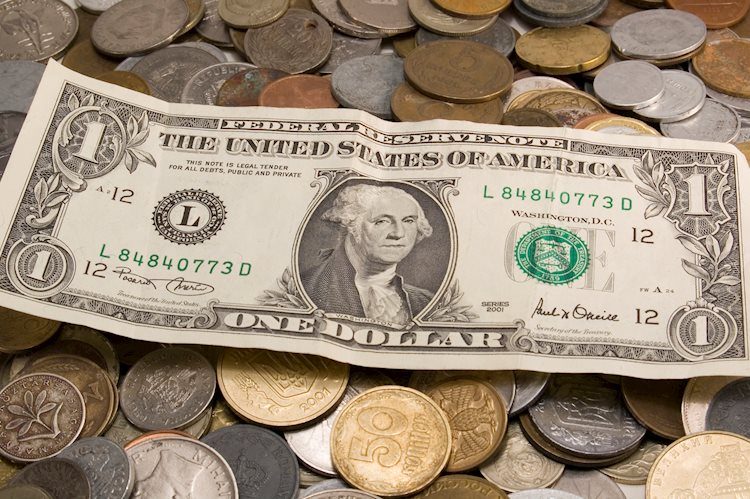
- The US Dollar holds on to Monday’s gain in a first step to recover last week’s losses.
- CPI release disappointed markets with no accelerated disinflation.
- The US Dollar Index trades back above 103.00 in its road to recovery.
The US Dollar (USD) is trading broadly in the green on Tuesday, after the release of the monthly US Consumer Price Index (CPI) numbers for Tuesday. More details can be found below though it appears that all numbers came in line of expectations. And markets are clearly not happy with that, with markets rather looking for a more speedy disinflationary path. This means in the rate cut reshuffle that May is out of the cards and focus is now rather on June and July.
The US Consumer Price Index (CPI) thus was broadly in line, besides the yearly components. Both the Yearly Core and the Yearly Headline CPI ticked up 0.1%, rather hitting the upper level of estimations foreseen in each segment. This sparked a bit of US Dollar weakness with markets paring back bets of a very quick rate cut in already May or June.
Daily digest market movers: Push back by a few weeks
- The NFIB Business Optimism Index for February has already been released around 10:00 GMT. Previous number was at 89.9 with the February number coming in at 89.4.
- The Consumer Price Index for February is to be released at 12:30 GMT:
- Monthly Headline CPI came in as expected at 0.4%, from 0.3% a month earlier.
- Yearly Headline CPI jumped from 3.1% to 3.2%.
- Monthly Core CPI remained stable at 0.4%.
- Yearly Core CPI declined from 3.9% to 3.8%.
- At 17:00 GMT, the US Treasury Department will head to markets to allocate a 10-year Note.
- Equities are sideways with one outlier to notice: The Chinese Hang Seng Index has jumped over 3% near its closing bell. US equity futures are in the green ahead of the CPI print, up 0.50%.
- According to the CME Group’s FedWatch Tool, expectations for a Fed pause in the March 20 meeting are at 97%, while chances of a rate cut stand at 3%.
- The benchmark 10-year US Treasury Note trades around 4.09%, and could snap below 4.00%, should inflation fall substantially.
US Dollar Index Technical Analysis: Not March, Not May…
The US Dollar Index (DXY) has tried to recover a touch on Monday, with still a very long road ahead to come back to levels where it was two weeks ago. The US CPI print is expected to move the needle a bit in terms of timing on the much-anticipated first rate cut from the Fed. However, simply moving the timing by a month means no big intraday moves are to be expected as traders will likely simply tweak their portfolio to the timing of the rate cut.
On the upside, the first reclaiming ground is at 103.31, the 55-day Simple Moving Average (SMA), and at the 200-day SMA near 103.71. Once broken through, the 100-day SMA is popping up at 103.74, so a bit of a double cap in that region. Depending on the catalyst that pushes the DXY upwards, 104.96 remains the key level on the topside.
The DXY is trading a bit in nomad’s land, with not really any significant support levels nearby. More downside looks inevitable with 102.00 up next, which bears some pivotal relevance. Once through there, the road is open for another leg lower to 100.61, the low of 2023.
Inflation FAQs
Inflation measures the rise in the price of a representative basket of goods and services. Headline inflation is usually expressed as a percentage change on a month-on-month (MoM) and year-on-year (YoY) basis. Core inflation excludes more volatile elements such as food and fuel which can fluctuate because of geopolitical and seasonal factors. Core inflation is the figure economists focus on and is the level targeted by central banks, which are mandated to keep inflation at a manageable level, usually around 2%.
The Consumer Price Index (CPI) measures the change in prices of a basket of goods and services over a period of time. It is usually expressed as a percentage change on a month-on-month (MoM) and year-on-year (YoY) basis. Core CPI is the figure targeted by central banks as it excludes volatile food and fuel inputs. When Core CPI rises above 2% it usually results in higher interest rates and vice versa when it falls below 2%. Since higher interest rates are positive for a currency, higher inflation usually results in a stronger currency. The opposite is true when inflation falls.
Although it may seem counter-intuitive, high inflation in a country pushes up the value of its currency and vice versa for lower inflation. This is because the central bank will normally raise interest rates to combat the higher inflation, which attract more global capital inflows from investors looking for a lucrative place to park their money.
Formerly, Gold was the asset investors turned to in times of high inflation because it preserved its value, and whilst investors will often still buy Gold for its safe-haven properties in times of extreme market turmoil, this is not the case most of the time. This is because when inflation is high, central banks will put up interest rates to combat it. Higher interest rates are negative for Gold because they increase the opportunity-cost of holding Gold vis-a-vis an interest-bearing asset or placing the money in a cash deposit account. On the flipside, lower inflation tends to be positive for Gold as it brings interest rates down, making the bright metal a more viable investment alternative.